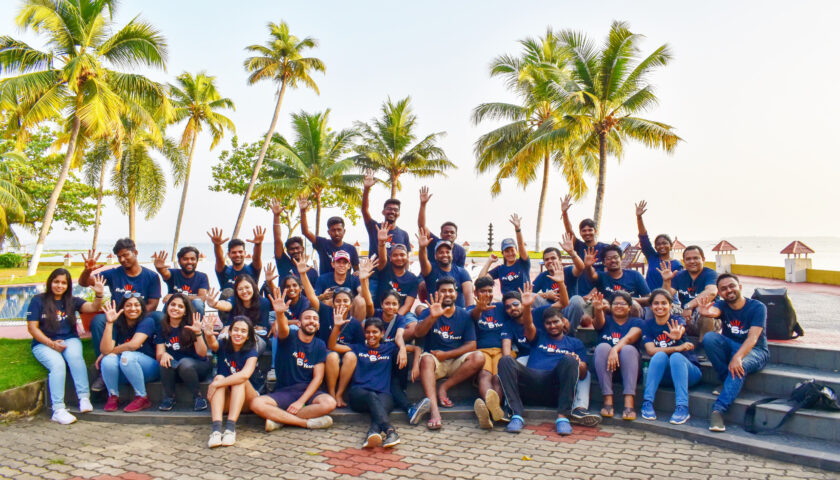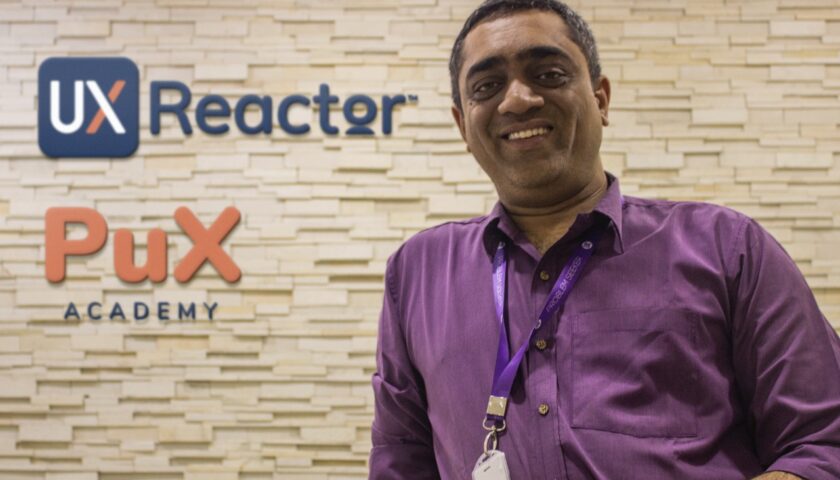
Small Enterprise magazine interviewed Prasad Kantamneni, Co-Founder, UXReactor – a UX Design Consultancy based out of California, and have a detailed discussion about his business approach, objectives, and plans.
Having worked for 20+ years with cutting edge brands like Yahoo and Honeywell as the technology architect, Prasad was responsible for user experience and business development in India and abroad.
He holds a Masters degree in Computer Science from Wright State University with enriching work experience in technology research, network security, and AI.
After having rich experience of two decades to his credit in the technology sector, Prasad co-founded UXReactor where he is handling innovation, training, and global operations.
Here is the verbatim transcript of the interview.

1. Your business model is unique! What inspired you to launch UXReactor?
UXReactor was founded by Satyam and me in 2015. Before UXReactor, we worked and consulted with several Fortune 500 companies such as Yahoo!, Citrix, PayPal, eBay, and Honeywell. Each of these companies invests significantly in Design, yet they struggle to find quality talent and the desired outcomes. We realized that most designers look at it as an art form, but all of the top companies require Design to be executed as a discipline. We identified it as an opportunity and came up with a system of doing design called the PragmaticUX™ approach.
We also realized that there were very few (about 100 seats) institutions that teach design as a Discipline – because there was no standard process of teaching it. The problem we faced was that there was nobody trained in the system, so we started a training institution PUX Academy with the exclusive goal of recruiting the best talent and training them in our system. Our recruitment criteria for training are extremely selective, where less than 70 candidates were selected from more than 17,000 applicants across the globe. The institution has recruited and trained people from across the globe including the US, Colombia, and India. All successful candidates were then absorbed by UXReactor.
Today our team works exclusively for the international market and designs next-generation products for companies ranging from global brands such as Nokia, Citrix, VMware, American Express to up and coming unicorns such as Tekion. The success of the system was proved last year when our product was recognized as a category leader by Fast Company for its user Experience. Other companies that won that year included Ikea, Google, IBM, etc.
This year we were recognized by Inc. 5000 for being the fastest-growing privately-owned specialty UX design company in the US. We would not have been a success had we not invested the time and effort in building our process and in recruiting and training the correct people.
2. Would you brief about UX Reactor and how it works?
UXReactor is a design consulting firm based out of California, with a presence in Hyderabad, India. It is a full-service User eXperience (UX) design firm, that helps teams and organizations in different stages of the business life cycle optimize their user-centered focus to deliver useful, usable, and desirable products. UXReactor has also been listed as the best design studio, on the prestigious Inc. 5000 list of fastest-growing private companies in the US for the year 2020 by registering a 174% growth over the 3 years.
Our vision at UXReactor is to be one of the top business consulting firms by 2025 – using the power of Design Thinking.
To achieve this objective, the key area of investments are:
- People: Hiring the correct people and investing in them
- Process: Creating Strong Design Process and problem-solving frameworks
- Environment: Nurturing the appropriate environment for people to achieve their potential with the help of the processes and frameworks developed.
From a business perspective, we help our clients create transformative value by engaging them as partners delivering business outcomes. We work with clients that need and understand the transformative value of Design – because that is where we can deliver the most amount of value. We are long term partners for companies because the User Experience (UX) solutions we develop require significant systemic thinking.
As part of our engagements, we don’t restrict ourselves to UX design, rather we help our partners set up processes, and train their product, business, and Engineering teams on the best way to build their capacity.
In terms of the larger philosophy, we are an outcome-driven company, consequently, we only work with clients for whom we can drive clear and measurable outcomes using our UX frameworks and processes.
We adopt a 3-in-a-box framework, where the UX team works closely with product managers and engineering to ensure the product experiences exceed user expectations while accomplishing the organization’s business goals. Each project is made up of a design unit containing a comprehensive toolkit with the 5 core UX skills i.e. Strategy, Research, Interaction Design, Visual Design, and Prototyping.
3. What was the core objective of launching such a concept of training platform?
In the last 5 years since we started, we realized that we have solved a significant number of problems that students and the industry at large have.
- Students don’t know where to get industry-relevant training. There are a lot of companies offering training but without practical exposure resulting to creating professionals who don’t know how to execute in the Industry.
- Companies on the other side are drowning in resumes of people whom they don’t know how to assess, or what to expect from them once they are hired. As a result, the average company spends at-least 12,50,000 on hiring the wrong people and loosing on market opportunities.
These are exactly the problems we have solved in the last 5 years of our existence. Now we want to share the best practices and help other companies scale their talent using our lessons learned.
To this end, we are working on two platforms
- Uxreactor.org – where students can come and learn all the necessary design concepts to build a strong foundation.
- Collej.co: where companies can come to leverage our lessons learned to build strong and sustainable design teams.
Through this initiative, we wish to bring India as a formidable player in the design map of the world. Our association with the universities is also directed towards ensuring that aspiring students get hands-on exposure to the best in global design and become globally competitive design professionals. In fact, through our initiative UX Academy, we would like to create a pool of world-class design professionals delivering disruptive designs for a delightful experience.
4. Who can benefit from your training and how?
UXReactor Open Training Platform is an open forum for Designers to learn and adopt the best techniques of Pragmatic UXDesign. The demand for UX designers is far bigger than the supply of experienced professionals who can deliver those insights. We have introduced the UXReactor Open Training platform available at uxreactor.org, it is a free online training resource extended to learn UX design from anywhere anytime.
The training material has been curated by industry practitioners who have experience working with some of the most innovative companies in the world. Candidates from diverse educational backgrounds with an eye for creative problem solving can benefit from the Open Training Program.
5. How you plan to expand your company?
In the last three years, our company has grown by 175% in terms of revenue, as a result, we were recognized by Inc. 5000 as the fastest-growing, privately held, specialty UX design company in the US. Our team has grown and matured similarly. We expect our revenue growth to be just as aggressive this year as well.
On the people front, we are expanding our global footprint by building a team in Medellin, Colombia. We currently have a team of 5 members there and are aggressively hiring. We anticipate that within two years, it will become a Center of EXcellence for emerging technologies such as Complex Data Visualization and AR/VR/MR.
We are excited to share that Tom Walter, the founding Creative Director for eBay and PayPal – recently joined our team. We are looking to double the size of our US team by June 2021. Overall, we are very bullish about our growth and prospects.
6. How people are responding to this concept of training and how fast is it gaining traction?
Every company we talk to has communicated the same problem about building strong design teams. On the flip side, students realize that the skills they have are not making them industry-ready. And finally, Universities are approaching us to help them with their curriculum.
Overall, everybody realizes that the grooming industry-ready design talent is a significant problem we will have to solve before the Indian business ecosystem can take the global state in larger numbers.
7. Do you see a need for more such companies in India and what’s the future of such initiatives in India?
Currently, there is a specific number of Design jobs just in India and the US. We alone cannot fulfil all of this, so we need more companies that can deliver the design on a global scale, along with institutions that can train students at scale.
What we are doing, is demonstrating a successful model to the rest of the industry, and hope to see some competition.
8. How was your journey as the owner of UX Reactor, and what challenges do you face?
The journey has been tough in many ways
- In the initial days, Designers did not believe that the system could be made better
- In India, UX Design was a niche discipline and limited to IIT’s and NID’s, and the scope of opportunities was not well known. As a result, most people were not willing to learn design
- Universities and colleges would not allow us to recruit on campus because of our stringent selection criteria
- Today the good news is that people understand the value of design – and at least 3 new design institutions are opening up every year. A number of these institutions have approached us for help in crafting and driving their design programs.
Today we have gone 180 degrees where people have gone from not knowing what design is, to have a strong demand for the discipline. There is a huge industry demand for the same. We look forward to doing our bit to making India a leader in design.
– Mamta Sharma
